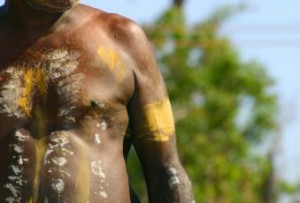By Steven Strong with Andy Whiteley
Contributing Writers for Wake Up World
Scientific evidence refuting the theory of modern humanity’s African genesis is common knowledge among those familiar with the most recent scientific papers on the human Genome, Mitochondrial DNA and Y-chromosomes. Regrettably, within mainstream press and academia circles, there seems to be a conspicuous – and dare we say it – deliberate vacuum when it comes to reporting news of these recent studies and their obvious implications.
This article was inspired by a comment made recently by Australian historian Greg Jefferys. So before continuing a scientific assessment of DNA evidence, we will first open this discussion by outlining Greg Jefferys’ comments.
The whole ‘Out of Africa’ myth has its roots in the mainstream academic campaign in the 1990’s to remove the concept of Race. When I did my degree they all spent a lot of time on the ‘Out of Africa’ thing but it’s been completely disproved by genetics. Mainstream still hold on to it.
[pro_ad_display_adzone id=”110028″]
It did begin the early 90’s. And the academics most responsible for cementing both the Out-of Africa theory and the complementary common ancestral African mother – given the name of “Eve” – in the public arena and nearly every curriculum, were Professors Alan C. Wilson and Rebecca L. Cann. In their defense, the authors of this paper were fully aware that genealogy is not in any way linked to geography, and that their placement of Eve in Africa was an assumption, never an assertion. In their seminal paper The Recent African Genesis of Humans, they even stipulated “that all humans today can be traced along maternal lines of descent to a woman who lived about 200,000 years ago, probably in Africa.”
So how is it that their “probably” has morphed into our collective “definitely”?
Over time, even the two researchers came to discover that the research of Original Mitochondrial DNA was fundamentally flawed. Both separately conducted further tests on Mitochondrial DNA found within the blood of full-descent Original people, arriving at the same conclusion, both recanted their previous assumptions by acknowledging that Homo sapien sapiens originated in Australia.
Professor Alan Wilson came to Australia in 1987 and 1989 to personally supervise the collection of Original blood from a variety of locations throughout Australia. With a mutation rate of 70% from the samples analysed, which is manifestly higher than any other race, Wilson was compelled to admit that:
… it seems too far out to admit, but while Homo erectus was muddling along in the rest of the world, a few erectus had got to Australia and did something dramatically different – not even with stone tools – but it is here that Homo sapiens emerged and evolved.
Rebecca Cann was more expansive and specific in declaring that the Original “Mitochondrial DNA puts the origin of Homo Sapiens much further back and indicates that the Australian Aborigines arose 400,000 years ago from two distinct lineages, far earlier than any other racial group.” The notions of a “far earlier” time frame when estimating when, and the existence of “two lineages” in Australia when grappling with who, are constant themes that can be found within many other reports investigating the make up of the genes and chromosomes of Homo sapien sapiens.
The very recent mapping of the Original Genome only reinforces the stance taken by both Cann and Wilson twenty years earlier, and highlights the inconsistencies and illogicality of any and every Out-of-Africa theory. A Danish genetic research team, led by Dr. Eske Willerslev, found that Original people came into existence at least 70,000 years ago, 40,000 years before both the European and Asian race first appeared. They assumed that because Africans made their way across the entire Asian continent and never stopped or settled, and remained in transit until reaching Australia “some 50,000 years ago.” Once ensconced in this foreign land where they managed to keep “the whole continent to themselves without admitting any outsiders”, their genes should be very African.
The problem being, as they openly admit, such a premise is “based on a mixture of statistics and best guesses”, and more importantly as Wilson and Cann came to realise, “we really can’t put geography in there.” Granted, they did concede that “the Aborigine occupation of Australia presents a series of puzzles” and especially so in relation to “the nature of their stone tools found in Australia” which “are much simpler than the Upper Paleolithic tools… at the same era.” Professor Richard Klien (Paleoanthropologist Stanford University) highlighted the contradictory nature of the stone tool technology in Australia when observing that “I don’t understand why they looked so primitive.”
Basically this means that the people who invented and sailed the first boat capable of carrying many people over 100 kilometres of open sea, regressed markedly in technology once arriving on these new shores. Or perhaps in ancient days until quite recent times, no-one ever sailed to, but from, Australia, which would explain why the Original technology was so unlike anything outside their home base.
Noted by Dr. Savolainen from the Royal Institute of Technology in Stockholm, even the arrival of the only dog to reach Australia until the British invasion is an “enigma”.
We would humbly suggest that proclaiming any genetic absolutes, when dealing with Australian history, is risky business and best left to the Original Elders.
What only complicates the convenient versions of history is the totally unexpected addition to the ever-expanding hominid family: the Denisovans. Just after the release of a paper on the mapping of the Original Genome from a piece of hair collected 100 years ago, the first news of a new species of hominid – called the Denisovans – reached the public arena. All evidence found – especially in relation to the mtDNA extracted from the little finger of a Denisovan woman believed to be 80,000 years old – widens the geographic boundaries and time-scales of this recurring “enigma”. First and foremost, the resulting mtDNA of this sub-species of modern humans was compared against every race and tribe on the planet, and the closest genetic match was, as we would have predicted, the Australian Original people.
Thirty thousand years before the first Africans supposedly entered Australia, Original, not African, genes turn up in Siberia. The real issue at stake is that the Denosovans are considered a lesser species of early human, placed somewhere below Neanderthals, while the Original people, according to every model, are fully Homo sapien sapiens. So how is it possible that this regression took place? And did so, so far from home?
Some commentators proposed that this contact was not due to Original people sailing from Australia, but the Denisovans sailing to Australia. But alas, to for the Denisovans to have done so is in opposition to every accredited theory on the rise of Homo sapien sapiens, where they alone mastered the art of sailing to other continents in numbers large enough to genetically sustain their founding populations. Apparently, the Denisovans, who are well down the Hominid tree, were able to communicate, construct a boat of sizeable proportions, and navigate a successful voyage of thousands of kilometers on the open seas. This hypothesis just doesn’t make sense. What does sound more logical was that Homo sapiens were actually sailing from Australia and bestowing wisdom, culture and genes, with the Denisovans gratefully receiving all of these gifts.
Now the plot thickens and unravels.
An article in the New York Times on 4th December 2013 lays claim to a “baffling 400,000 year old clue to human origins”. On this occasion, humanity’s indirect ancestry was traced back to Spain during pre-Homo sapien sapiens times, and once again Denisovan genes are at play. So it appears the same hominid who is most closely linked to the Original genes of Australia was wandering around the Spanish countryside some 400,000 years ago, well before any African Homo sapien could be claimed to have stepped in, on or outside African soil.
“Scientists have found the oldest DNA evidence yet of humans’ biological history. But instead of neatly clarifying human evolution, the finding is adding new mysteries”. The femur bone found in cave was analysed by Dr. Matthias Meyer (geneticist Max Planck Institute for Evolutionary Anthropology). When Meyer and his colleagues “drilled into the femur, they found ancient human DNA inside, just as they hoped”.
But past this point, nothing went according to their script. Much to their surprise, the DNA they recovered – the oldest yet by over 100,000 years – “most closely resembles DNA from an enigmatic lineage of humans known as Denisovans”, originally thought to be 80,000 years old and confined to the Northern Asian region. This finding was the cause of great consternation. “Everyone had a hard time believing it at first” Dr. Meyer said. “So we generated more and more data to nail it down”. Not surprisingly, their further research only confirmed the original results.
As Meyer quite rightly observed: “right now, we’ve basically generated a big question mark”.
As was the case with the Genome studies of Original hair, “the new finding is hard to reconcile with the [accepted] picture of human evolution”. None of what they found fits into any traditional version of human ascension, and according to Dr. Luis Asauaga (Paleoanthropologist, Universdad Complutense de Madrid) this discovery demands that “we have to rethink the whole story”.
And that last statement by Dr. Asauaga really sums up the case for the entire Out-of-Africa theory: it is a “story”, it was never a fact. From the very beginning it was always a “probably” at best. But this is only one half of the story… all of the evidence we have presented relates to women’s side of the genetic pool, and until the male’s Y-Chromosome is factored into this ancient narrative, any “rethink” of the “whole story” is incomplete.
What really does reinforce Greg Jeffreys’ contention that the genetic evidence is in stark contradiction to any Out-of-Africa theory, is that time after time the many Y-Chromosome papers released over the last decade stand united in their denial of any African input. And this is by no means a recent occurrence, as evidenced by a paper released in 1999 by Australian researchers Vandenburg and colleagues. As it was with other studies, the results were as inconvenient as they were unexpected. Vandenburg found that “Australian Y-chromosome diversity is surprisingly limited”. In contrast with the Genome researchers’ assumption that Australian was literally sealed off genetically until their land was stolen in 1788, Vandenburg made note of “two haplotypes unique to Australian Aboriginals”. But if indeed Africans sailed to Australia and were immediately isolated genetically, this just should not happen – every Original haplotype should have close to an identical African match.
Further information added to the African inconsistencies, while also reinforcing an observation offered by Rebecca Cann in relation to mtDNA evidence that suggested the first Original Homo sapien sapiens were sourced from “two lineages”. The results gathered “were compared with other worldwide populations” which “produced 41 unique haplotypes”. Instead of an even spread amongst so many haplotypes, in Australia a far more intense clustering was present in that “most (78%) of Australian haplotypes fell into two clusters, possibly indicating two original, separate lineages of Aboriginal Australians”. To that end, since at least two Original haplotype groups have no African counter-part, there can be no African involvement, mtDNA or Y-chromosomes in either of the “two lineages”.
As such, a very recent paper on Y-chromosomes released in 2012, (Re-Examing the “Out of Africa” Theory and the Origin of Europeoids (Caucasians) in the Light of DNA Genealogy written by Anatole A. Klyosov and Igor L. Rozhanski) only confirms the denial of any African ancestry in Australia, and strongly supports the existence of a “common ancestor” who “would not necessarily be in Africa. In fact, it was never proven that he lived in Africa”.
Central to results of this extensive examination of haplogroups (7,556) was the absence of any African genes. So lacking was the sampling of African genetic involvement, the researchers stated in their introduction that:
“the finding that the Europeoid haplogroups did not descend from “African” haplogroups A or B is supported by the fact that bearers of the Europeoid, as well as all non-African groups do not carry either SNI’s M91, P97, M31, P82, M23, M114, P262 …”
There are 11 more entries in this list of non-starters, all missing from both Europeoids and “all non-African groups,” which obviously includes the Original Australians. With the Original people exhibiting an intense clustering into two groups, haplogroups not present in any African genes and an absence of dozens of African genetic markers, it is very difficult nigh on impossible to sustain any link between Africa and Australia.
The researchers are adamant that their extensive study “offers evidence to re-examine the validity of the Out-of-Africa concept”. They see no genetic proof substantiating an African precedence in the Homo sapien tree, and maintain that “a more plausible interpretation might have been that both current Africans and non-Africans descended separately from a more ancient common ancestor, thus forming a proverbial fork”.
We regard the claim of “a more plausible explanation” as a gross understatement, since there is absolutely nothing plausibly African turning up in any test tubes. In fact, the researchers made note of their repeated absence stating “not one non-African participant out of more than 400 individuals in the Project tested positive to any of thirteen ‘African’ sub-clades of haplogroup A”.
The only remaining uncertainty relates to the identity of this “more ancient common ancestor”. All that can be stated with confidence is that humanity’s ancestor did not reside in Africa, but “probably” Australia.
When an Original Elder of high standing recently declared that “all peoples of the world come from us”, it seems he had a large body of genetic science standing beside him.
About the authors:
Steven Strong is an Australian-based researcher, author and former high school teacher. Together woth his son Evan, his work is to explore the ancient story of the Original people, a narrative that was almost lost to aggressive European colonisation.
Andy Whiteley an average 40-something from Melbourne Australia who, like many people, “woke up” and realized everything isn’t what it seems. Since then, he feels blessed to be a part of Wake Up World and its amazing community of readers.
This article © Wake Up World.
[pro_ad_display_adzone id=”110027″]







